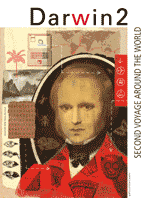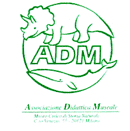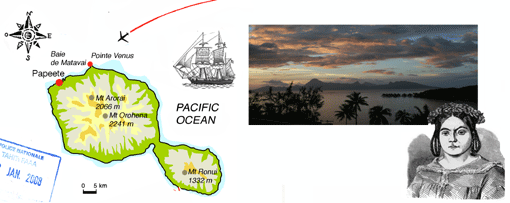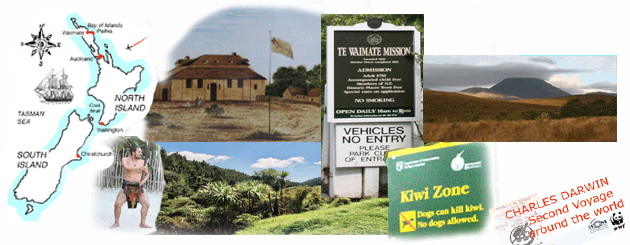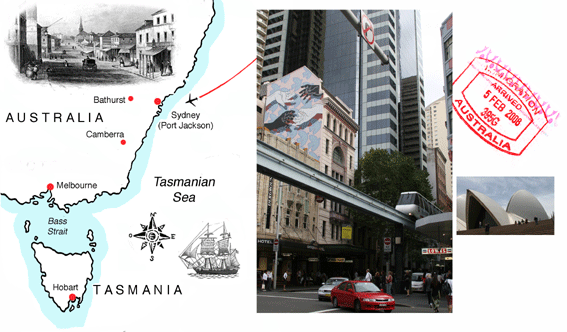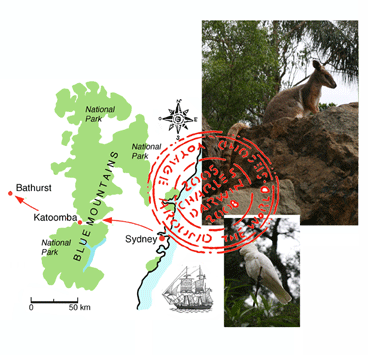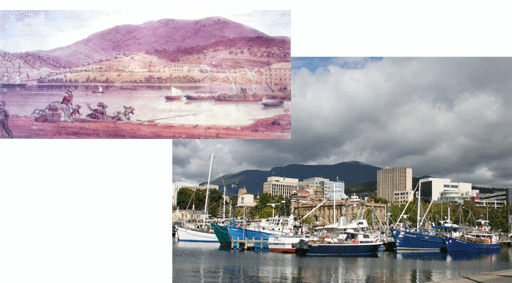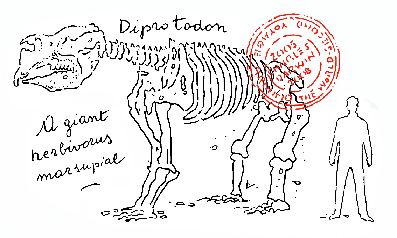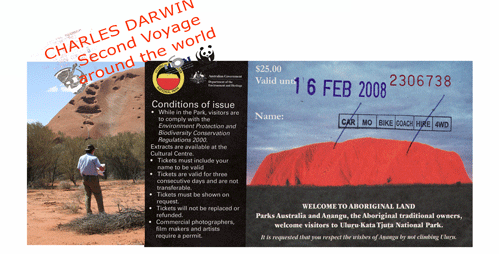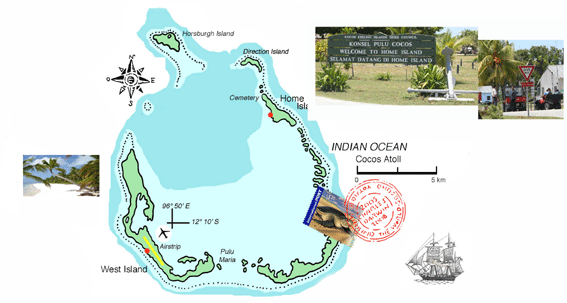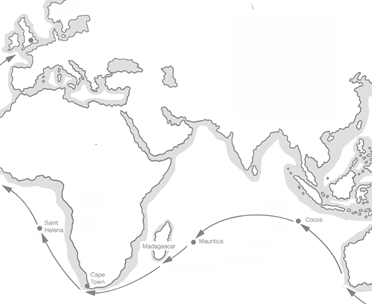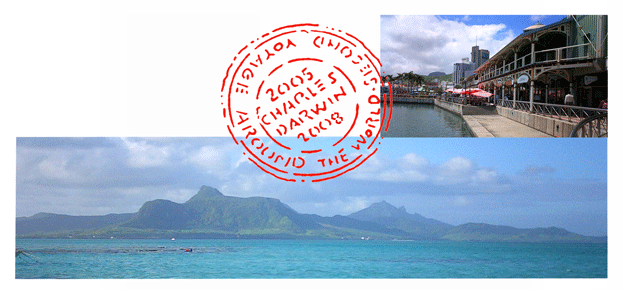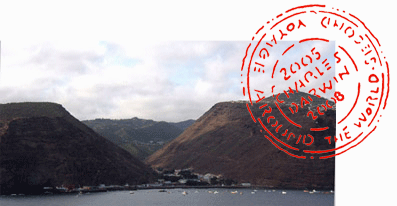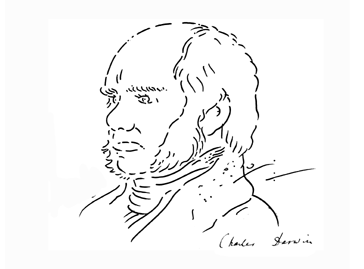Charles Darwin/Second Voyage Around the World (2005-2009) Step Tahiti, New Zealand, Australia. Tasmania, Cocos-Keeling islands, London (summary)
Darwin's Second Voyage goes on. It began in October 2005. After Galàpagos, January 10th, 2008 Darwin2 Mission starts from Los Angeles.
1. Tahiti
November 25th, 1835 "In the evening four boats were sent for her majesty; the ship was dressed with flags, and the yards manned on her coming on board. She was accompanied by most of the chiefs. The behaviour of all was very proper: they begged for nothing, and seemed much pleased with Captain Fitz Roy's presents. The queen is a large awkward woman, without any beauty, grace or dignity. She has only one royal attribute: a perfect immovability of expression under all circumstances, and that rather a sullen one. The rockets were most admired, and a deep "Oh!" could be heard from the shore, all round the dark bay, after each explosion. The sailors' songs were also much admired; and the queen said she thought that one of the most boisterous ones certainly could not be a hymn! The royal party did not return on shore till past midnight". Charles Darwin, The voyage of the Beagle Tahiti, Photo and map by Luca Novelli/Darwin2 January 2008 and Pomarè Queen's Portrait. 2. Waimate, New Zealand December 23rd, 1835 "At a place called Waimate, about fifteen miles from the Bay of Islands, and midway between the eastern and western coasts, the missionaries have purchased some land for agricultural purposes. I had been introduced to the Rev. W. Williams, who, upon my expressing a wish, invited me to pay him a visit there. Mr. Bushby, the British resident, offered to take me in his boat by a creek, where I should see a pretty waterfall, and by which means my walk would be shortened. He likewise procured for me a guide". Charles Darwin, The voyage of the Beagle
Waimate, New Zealand , Photos and map by Luca Novelli/Darwin2 January 2008.
3. Sydney, New South Wales, Australia January 12th, 1836 "At last we anchored within Sydney Cove. We found the little basin occupied by many large ships, and surrounded by warehouses. In the evening I walked through the town, and returned full of admiration at the whole scene. It is a most magnificent testimony to the power of the British nation. Here, in a less promising country, scores of years have done many more times more than an equal number of centuries have effected in South America. My first feeling was to congratulate myself that I was born an Englishman. Upon seeing more of the town afterwards, perhaps my admiration fell a little; but yet it is a fine town. The streets are regular, broad, clean, and kept in excellent order; the houses are of a good size, and the shops well furnished. It may be faithfully compared to the large suburbs which stretch out from London and a few other great towns in England; but not even near London or Birmingham is there an appearance of such rapid growth". Charles Darwin, The voyage of the Beagle
Sydney, Australia, Photos and map By Luca Novelli/Darwin2, February, 2008 (King Steet in Sydney, Sketch of F.C.Terry, 1852) .
4. Blue Mountains January 17th, 1836 "Early in the morning we passed the Nepean in a ferry-boat. The river, although at this spot both broad and deep, had a very small body of running water. Having crossed a low piece of land on the opposite side, we reached the slope of the Blue Mountains. The ascent is not steep, the road having been cut with much care on the side of a sandstone cliff. On the summit an almost level plain extends, which, rising imperceptibly to the westward, at last attains a height of more than 3000 feet. From so grand a title as Blue Mountains, and from their absolute altitude, I expected to have seen a bold chain of mountains crossing the country; but instead of this, a sloping plain presents merely an inconsiderable front to the low land near the coast. From this first slope, the view of the extensive woodland to the east was striking, and the surrounding trees grew bold and lofty. But when once on the sandstone platform, the scenery becomes exceedingly monotonous; each side of the road is bordered by scrubby trees of the never-failing Eucalyptus family; and with the exception of two or three small inns, there are no houses or cultivated land: the road, moreover, is solitary; the most frequent object being a bullock-waggon, piled up with bales of wool". Charles Darwin, The voyage of the Beagle
Blue Mountains , Australia, Photos and map by Luca Novelli/Darwin2, February, 2008. 5. Hobart, Tasmania January 17th, 1836 "Late in the evening we anchored in the snug cove, on the shores of which stands the capital of Tasmania. The first aspect of the place was very inferior to that of Sydney; the latter might be called a city, this is only a town. It stands at the base of Mount Wellington, a mountain 3100 feet high, but of little picturesque beauty; from this source, however, it receives a good supply of water. Round the cove there are some fine warehouses and on one side a small fort. Coming from the Spanish settlements, where such magnificent care has generally been paid to the fortifications, the means of defence in these colonies appeared very contemptible. Comparing the town with Sydney, I was chiefly struck with the comparative fewness of the large houses, either built or building. Hobart Town, from the census of 1835, contained 13,826 inhabitants, and the whole of Tasmania 36,505". Charles Darwin, The voyage of the Beagle
Darwin2 in Hobart, Tasmania, February, 2008 6. Melbourne (Only Darwin2 step)
Extinct megafauna in Melboune Museum, sketch of Luca Novelli, Darwin2, February 2008 7. Uluru (Only Darwin2) The center of Australia was completely unexplored when Darwin visited it in 1835. Of the "red center" he could onlu breath the hot desert wind at Bathurst more than 2000 klm far from Ayers Rock. This time Darwin and his travel companions reached the Uluru monolite and the Olga mountain chain (Kata Tjuta) . Here the official painter of the mission sketched the landscape in view of making later on a big painting the same as done by drawers who had accompanied him during his voyage on the Beagle. February 16th, 2008
Darwin2, Federico Canobbio Codelli in front of the Uluru mountain and the ticket to the National Park Below: Kata Tjuta, sketch of Federico Canobbio Codelli.
8. Cocos, Keeling April 12th. 1835 In the morning we stood out of the lagoon on our passage to the Isle of France. I am glad we have visited these islands: such formations surely rank high amongst the wonderful objects of this world. Captain Fitz Roy found no bottom with a line 7200 feet in length, at the distance of only 2200 yards from the shore; hence this island forms a lofty submarine mountain, with sides steeper even than those of the most abrupt volcanic cone. The saucer-shaped summit is nearly ten miles across; and every single atom, [10] from the least particle to the largest fragment of rock, in this great pile, which however is small compared with very many other lagoon-islands, bears the stamp of having been subjected to organic arrangement. We feel surprise when travellers tell us of the vast dimensions of the Pyramids and other great ruins, but how utterly insignificant are the greatest of these, when compared to these mountains of stone accumulated by the agency of various minute and tender animals! This is a wonder which does not at first strike the eye of the body, but, after reflection, the eye of reason". Charles Darwin, The voyage of the Beagle
Cocos, Keeling Islanda. Indian Ocean. Photos and map by Luca Novelli/Darwin2, February, 2008.
9. On the way homewards
Mauritius, Indian Ocean APRIL 29th. 1835 "In the morning we passed round the northern end of Mauritius, or the Isle of France. From this point of view the aspect of the island equalled the expectations raised by the many well-known descriptions of its beautiful scenery. The sloping plain of the Pamplemousses, interspersed with houses, and coloured by the large fields of sugar-cane of a bright green, composed the foreground. The brilliancy of the green was the more remarkable because it is a colour which generally is conspicuous only from a very short distance. Towards the centre of the island groups of wooded mountains rose out of this highly cultivated plain; their summits, as so commonly happens with ancient volcanic rocks, being jagged into the sharpest points. Masses of white clouds were collected around these pinnacles, as if for the sake of pleasing the stranger's eye. The whole island, with its sloping border and central mountains, was adorned with an air of perfect elegance: the scenery, if I may use such an expression, appeared to the sight harmonious". Charles Darwin, The voyage of the Beagle
Mauritius & St. Louis. Darwin2, Photo by Carolina Malinverni (20th marzo 2008). *** St. Helena (Napoleon's Island), Atlantic Ocean May 9th.1835. "We sailed from Port Louis, and, calling at the Cape of Good Hope, on the 8th of July, we arrived off St. Helena. This island, the forbidding aspect of which has been so often described, rises abruptly like a huge black castle from the ocean. Near the town, as if to complete nature's defence, small forts and guns fill up every gap in the rugged rocks. The town runs up a flat and narrow valley; the houses look respectable, and are interspersed with a very few green trees. When approaching the anchorage there was one striking view: an irregular castle perched on the summit of a lofty hill, and surrounded by a few scattered fir-trees, boldly projected against the sky". Charles Darwin, The voyage of the Beagle
St.Helena, Darwin2, Photo by Annamaria Passaro (8th september 2006) *** Ascension, Atlantic Ocean July 19th, 1835. "Those who have beheld a volcanic island, situated under an arid climate, will at once be able to picture to themselves the appearance of Ascension. They will imagine smooth conical hills of a bright red colour, with their summits generally truncated, rising separately out of a level surface of black rugged lava. A principal mound in the centre of the island, seems the father of the lesser cones. It is called Green Hill: its name being taken from the faintest tinge of that colour, which at this time of the year is barely perceptible from the anchorage. To complete the desolate scene, the black rocks on the coast are lashed by a wild and turbulent sea". Charles Darwin, The voyage of the Beagle
Ascension, Darwin2, Photos by Annamaria Passaro (16th september 2006) *** 10. London, Europe October 2th 1836 "On the last day of August we anchored for the second time at Porto Praya in the Cape de Verd archipelago; thence we proceeded to the Azores, where we stayed six days. On the 2nd of October we made the shore, of England; and at Falmouth I left the Beagle, having lived on board the good little vessel nearly five years". Charles Darwin, The voyage of the Beagle
"Our project "Charles Darwin/Second Voyage around the World" stops at the Heathrow airport . From 15th Oct. 2008 to 19th Oct. 2008 we'll be at the Frankfurt Book Fair with Rizzoli/Rcs Publishers and those publishers who have already bought the rights of the three volumes which tell our adventure started in spring 2005. Other missions have started in the meantime. The same as our enterprise, they will have to be shared, as well as all knowledge adventures and all evidences of Nature to be protected beneath the boundaries and national interests". Luca Novelli & Partnes, June 2008 *** |

